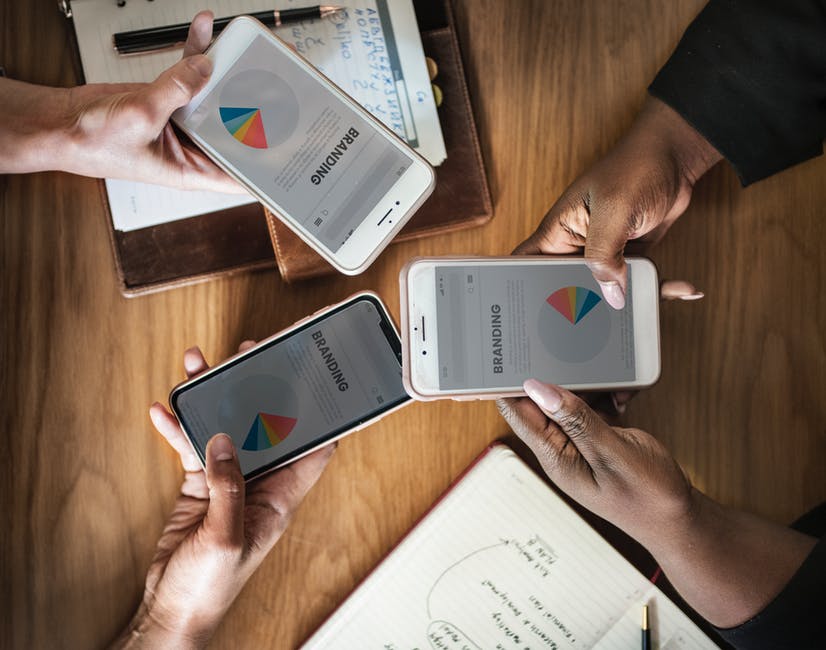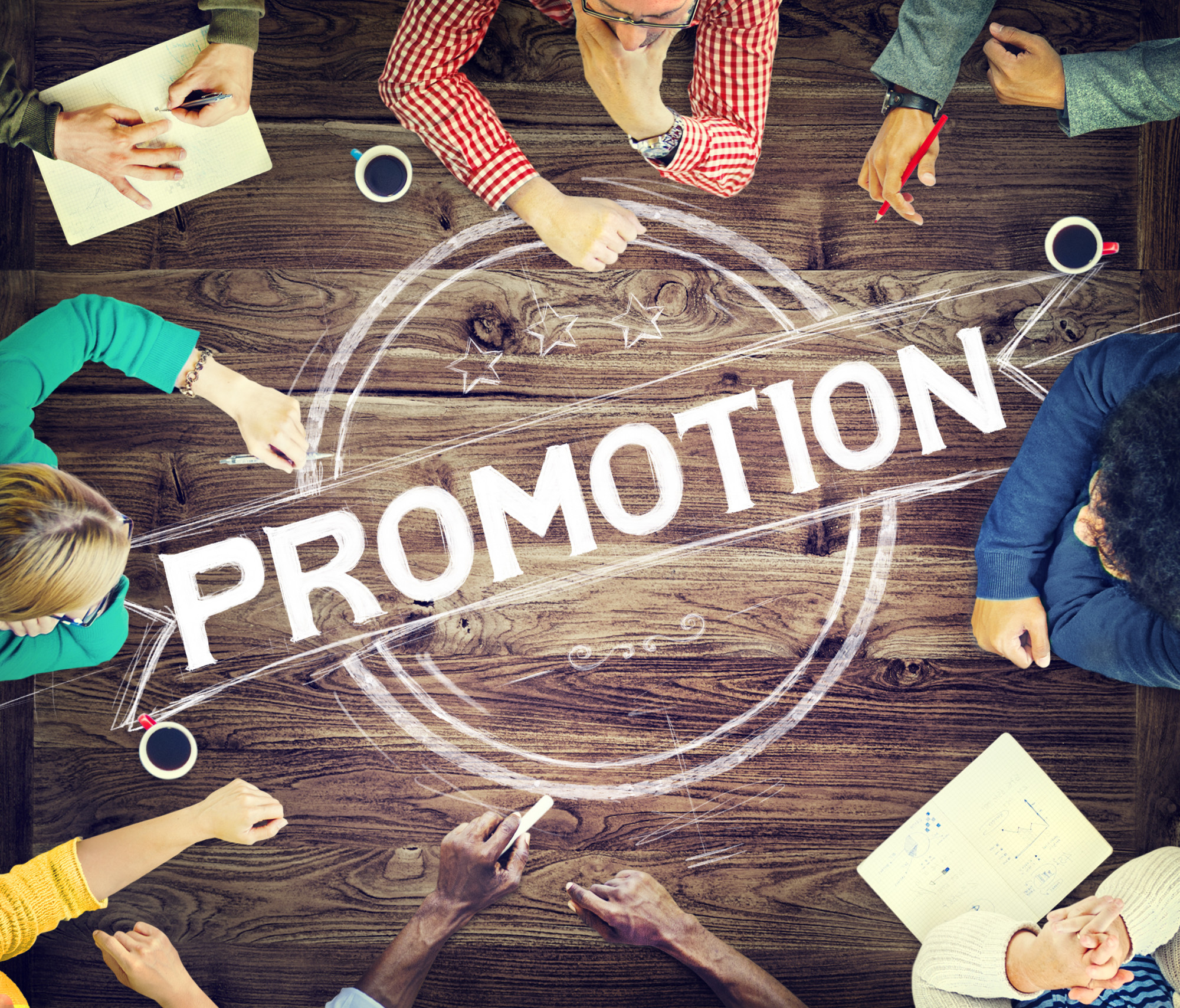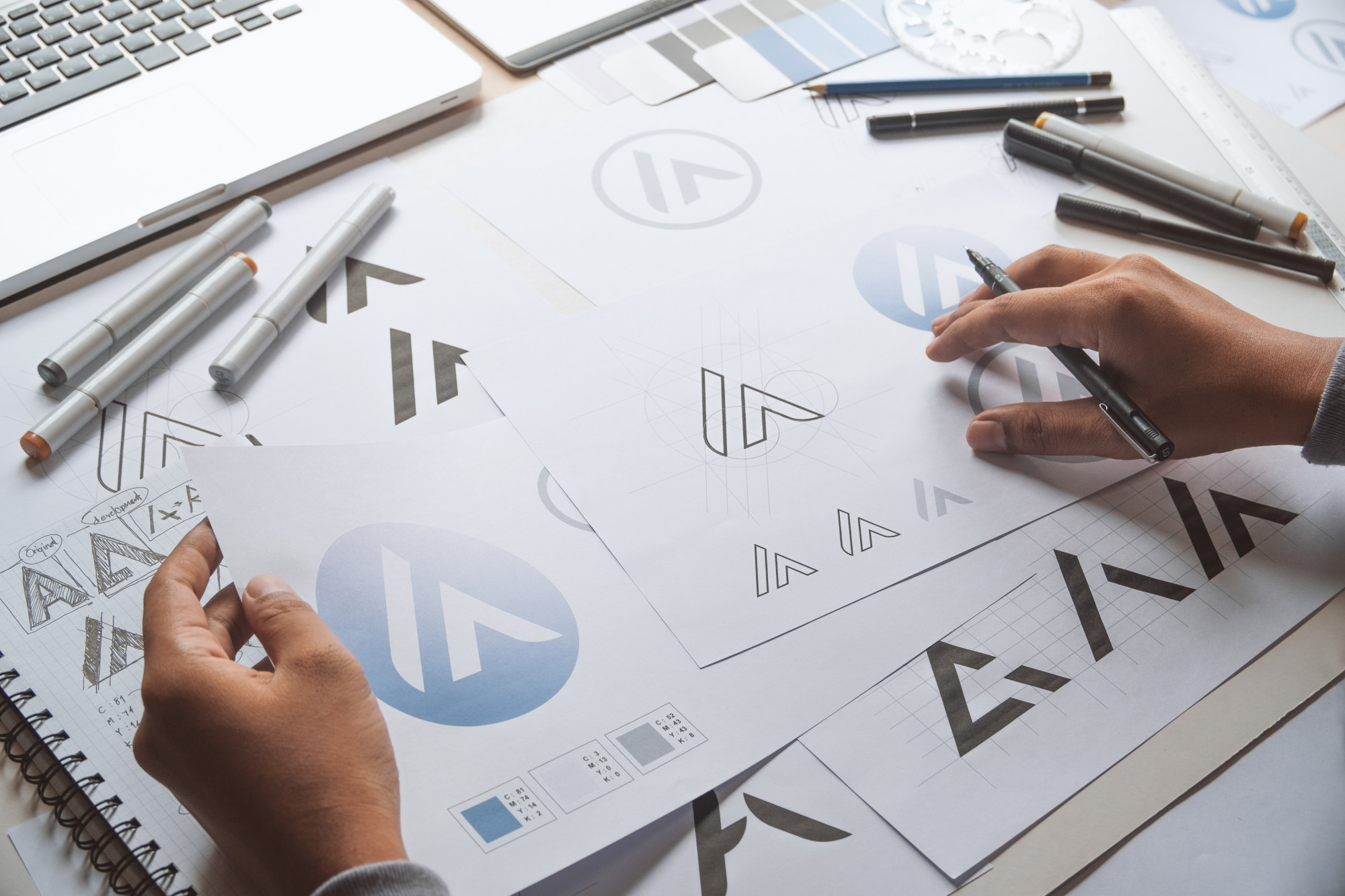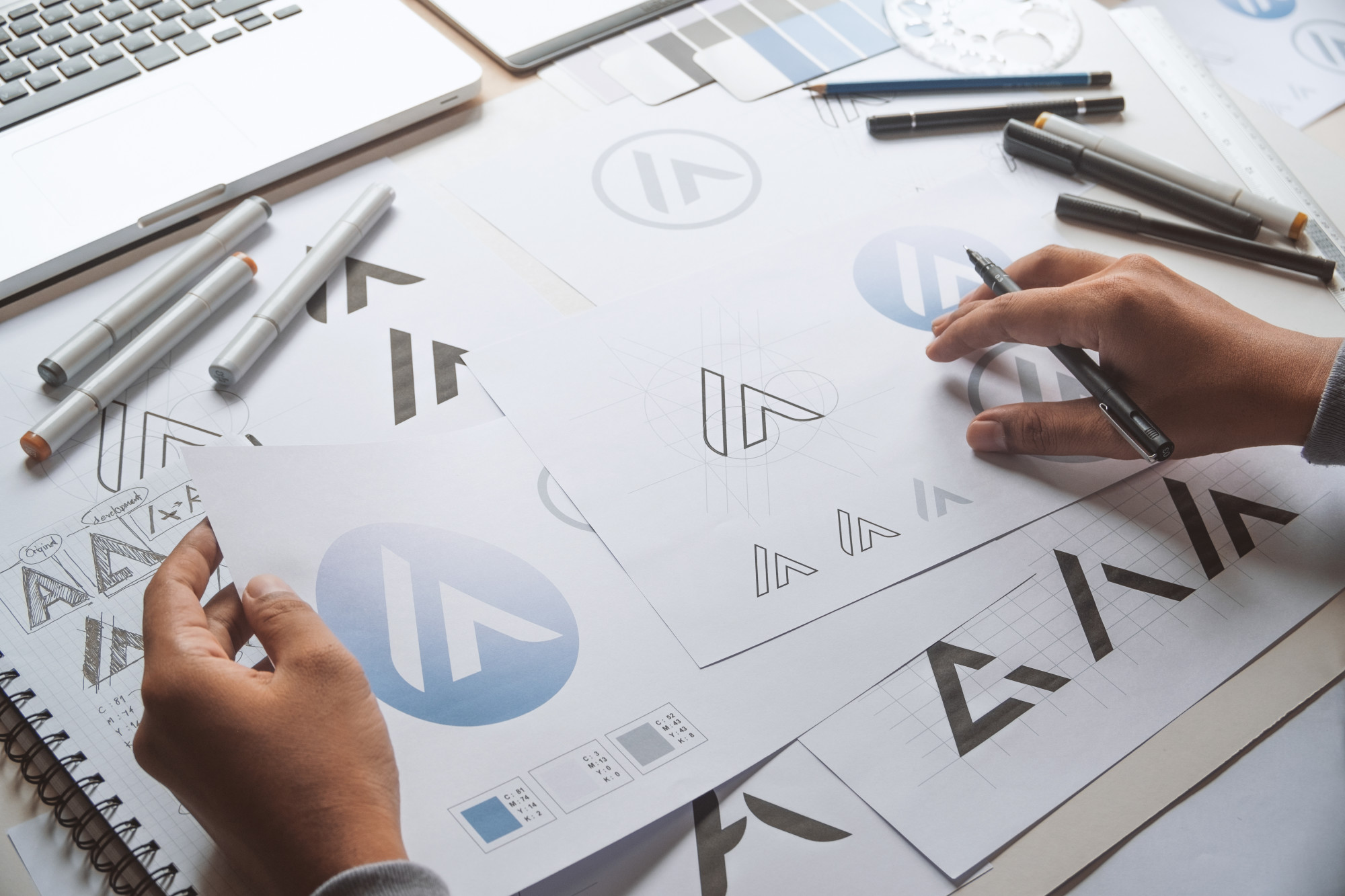Logo Design Principles: How to Create a Remarkable Company Logo
Posted on August 25, 2019 by Logo Design Tips and Tricks

Did you know the hidden arrow in the FedEx logo represents precision and speed?
Are you looking to design your logo but not sure where to begin? Not to worry! In this guide, we’ll go over design principles to use as you create your logo.
Want to learn more? Keep reading to find out.
Keep It Simple
Take a moment to think of the most famous brands in the world. Did you think of McDonald’s or Apple? Those two companies have a simple logo that’s recognized around the globe.
When working on your logo, go simple instead of complex. A simplistic logo is easy to print and can engage your audience instead of confusing them.
Choose a Balanced Logo
A logo is an icon no matter if it’s a graphic symbol or text. When creating a logo, you want to maintain a sense of balance. Don’t place elements together at random.
When thinking about the look, keep your audience, and services in mind. Pick a logo that has a balanced appearance reflecting your business.
Think About Symbols
Your logo doesn’t have to describe what your business does. For example, most shoe manufacturers don’t choose a shoe as their logo.
Pick an icon that can still communicate your brand without using the company name. This way, you can use the icon as an image that stands alone on the packaging.
If it’s too obvious, a viewer won’t experience the sense of discovery. Try not to go too abstract.
Easy to Adapt
Your logo should work on a small business card or a massive billboard. Use it on a t-shirt, brochures, or stamps. A strong logo will look great with different colors or one color.
When working on your logo, imagine how it will look on different marketing materials. This will help you make sure it’s flexible and looks striking in various formats.
Take Your Time Deciding on Colors
Before picking a color, think about what message you’ll send to customers. Do the colors reinforce the mood you’re trying to communicate? Blue can express loyalty, freshness, and trust. Green symbolizes cleanliness and nature.
Think about what colors work well with white and black backgrounds. Don’t include more than three colors in a logo. Too many colors will increase the cost when you have to print materials.
Uniqueness Factor
Will your logo stand out from the competition? Keep working on your logo if you think it’s too predictable or bland. You don’t want it to become invisible to your audience. Avoid typical cliches like pinwheels and clip art.
Research your competition. If your business is a PayStubCreator, research the industry and watch for patterns. Avoid mimicking those logos and create something that stands out.
Logo Design Principles
We hope you found this guide on creating a memorable logo helpful. With these logo design principles, brainstorm your company’s future logo.
Don’t forget to bookmark our site. This way, you won’t miss out on any of our resources.
Let Your Logo Shine: The Brilliant Benefits of Promotional Products
Posted on August 21, 2019 by Logo Design Tips and Tricks

If you’ve gone through the process to create a great logo for your business, you want it to be seen as much as possible.
Breaking through the clutter of marketing messages is often seen as the biggest barrier for business owners to get new clients.
Promotional products can be used to help your business cut through the noise. It’s a $23 billion industry because companies see huge benefits by spending marketing dollars on promotional products.
Read on to find out how promotional products can help you build your business.
1. Build Your Brand
Your brand is the base of your business. The stronger your brand is, the more you’ll be able to grow your business. A good brand goes beyond the logo. It’s the connection that people have with your company.
As a business, you promise something to your customers. It can be a superior product, excellent service, or both. Your brand conveys that promise to your customers so when they think of your company, that promise is the first thing that comes to mind.
Look at a brand like Volvo. They go beyond selling cars and promise safety and security.
How can promotional products help you fulfill that promise? First of all, they help you set your brand apart from your competition. There will be no confusion between your brand and the competition.
Secondly, when your company’s logo is seen often, like on promotional products, people are more likely to remember it.
2. Recruit Top Employees
You’re going to spend a lot of time and money to hire employees. You want to make sure that you get the right employee, to begin with.
Promotional products can instill a sense of company pride among your employees, whether they’re new employees or have been around for a while.
When you present promotional products to new hires as part of their welcome package, you’re building a sense of loyalty that can drive employee engagement.
You can also use promotional products at job fairs and recruiting events. This will help prospective employees identify more strongly with your company.
Another great use of promotional products is to create teams within your company. It can spur on a friendly competition to do better. You can separate teams by using patches with different team names on them. View here for more ideas to use promotional patches.
3. Create Loyal Customers
Not only do you want your employees to be loyal, but you also want your customers to be loyal, too. Customers that feel that they are appreciated are more likely to remain your customers rather than go to a competitor.
You can show your appreciation for your customers by giving them gifts. You can give them cards and gift cards to local restaurants. You can also give them promotional products.
People love free stuff that has a purpose, so you want to make sure that your products will be used by customers. For example, a company that deals with corporate executives can use pens or keychains with USB drives on them.
If you have a fitness business and work with an active crowd, water bottles, t-shirts, and bags would be appropriate.
4. Improve Digital Marketing
Did you know that promotional products can impact your digital marketing efforts? Here’s how promotional products usually work.
Someone becomes aware of your brand through a promotional product, such as a pen or a t-shirt. They’re intrigued by your brand and they noticed your website on the promotional product. They look you up out of curiosity.
They don’t need your services right now, so they decide to revisit your company later. When they need your services down the road, they’ll do a search online. They’ll remember your company name and when they see it in search results, they will click through to your website and book an appointment.
5. Higher Brand Recall
Part of the reason why promotional products work so well with digital marketing is that they lead to higher brand recall.
Brand recall is the ability of someone to remember your brand when they see it. About 76% of people remember a brand from promotional products.
In traditional advertising like newspaper ads and billboards, it can take between 6-7 impressions before your brand is remembered.
6. Look Professional
Do you deliver products directly to clients? You don’t want your employees to look like they just threw on what was clean and roll out the door.
You want them to look polished and professional. After all, they represent your business. It’s the same when you go to a trade show. When you wear the same shirts with your branding, you look like a unified unit as opposed to a team of individuals.
7. Promotional Products Deliver ROI
You want to see a return on investment anytime you spend money. It’s no different with promotional products. Promotional products help your brand stand out and be remembered. How does that translate into sales?
People hang on to promotional products, with some lasting over one year. That creates a lot of impressions in the mind of the person who owns the promotional product and the people around them.
The more impressions, the more your company will be remembered. When someone is ready to use your services, they will remember your name. That’s who they’ll call first.
If you give promotional products to current customers, 79% of them say that they will do business with you again.
You probably spent $8 on a t-shirt, but if it lasts longer than a year, think of the number of impressions that will generate. Then there are the sales that come from that. That’s how you know that you have a return on investment.
Promotional Products Are a Smart Investment
You want your business to stand out from the competition. That’s how you’re going to get new customers to your business.
There are plenty of reasons to use promotional products. Customers and employees love them. They create a more loyal fanbase and generate a return on investment.
Do you need a spiffy new logo to put on your promotional products? Create your own using our logo maker.
Make a Statement: How to Print Your Logo on Marketing Products
Posted on August 21, 2019 by Logo Design Tips and Tricks

It’s a given that promotional products work, but did you know that they may even work better than digital ads? Let’s look at the evidence in numbers.
A single promotional bag generates around 5,700 impressions. 85% of consumers also remember the company more because of a t-shirt or a hat.
This means nothing still beats a physical product when it comes to increasing brand awareness and brand visibility.
These numbers say something about the effectiveness of a promotional product, but it doesn’t include the quality of those products.
If you’re planning to print logo images of your company, make sure you choose the right method. You’ll get more out of your investment by ensuring the quality. Read on to know the steps on how to do it right.
1. Prepare the Logo File
You must first have the logo file prepared. It should be compatible with the method of printing you want, which we’ll discuss later.
Your logo should have vector graphics. This will make it easier for you to scale it up or down depending on the material you want it printed on. This allows you to print it on small products like mugs or big marketing materials like banners without it losing quality.
Make sure it doesn’t have a background, too, not even a white background. It should be transparent. If it has a white background, the printed logo will have a white rectangular frame.
As for the colors, consider the product you want to print it on, too. For colorful bottles, consider putting a monotone logo, for instance.
2. Choose a Logo Printing Method
Once you have your print logo file ready, choose how you want to print it on your marketing product of choice. The right method will also depend on the material. We’ll explain it more below.
Heat Transfer
In this method, you print the image on a sublimation transfer film. This then utilizes the heat from a heat press to transfer the design to another object. Note that the result looks glossy with bright colors.
This method is great for t-shirts, mugs, bags, and more. In general, you can use this method for fabric, plastic, and ceramic materials.
Silkscreen Printing
Silkscreen printing has been in use for over a century. Even today, it remains an effective method of printing.
It’s a popular method for printing on t-shirts. But you can also use this method to print on wood, paper, ceramic, and other materials. You can also use it to print your logo on suitcases, umbrellas, and other objects with flat surfaces.
The printing process involves a screen, a sheet of plastic with cut-outs, and a squeegee. You place the screen on top of the object, then place the sheet of plastic, and then use a squeegee to coat the screen with ink. This “prints” the image on the sheet of plastic onto the object.
Laser Engraving
As this method’s name implies, it uses a laser to engrave words or images onto materials like wood and metal. For metal products, you have to use the cool laser type and the heat laser for non-metal objects.
It’s easy, fast, and it allows you to create beautiful images on a variety of objects. If you use it on glass, it can create beautiful artworks without breaking the material.
The best thing about this method, though, is that it’s one of the cheapest methods there is.
Embroidery
You don’t have to do actual embroidery in this method; you leave this process to the machines. They “print” any image on the object using needles, threads, and a machine that does embroidery. This leaves a 3D and textured print.
As you can guess, this method is only good for promotional products made of fabric. It’s great for hats, bags, t-shirts, and so on. You can even create a different lanyard option using this method.
3. Buy the Needed Materials
For the printing method you choose, you must buy the corresponding equipment. You’ll need a laser engraving machine, for instance, whose costs depend on the size, power, and capacity.
You will also have to take these into account when buying the right equipment.
You’ll also have to prepare the materials you want your printed logo on. Make sure that the products are also compatible with the printing method of your choice.
Silkscreen printing is inexpensive for the most part, but for the other printing methods, you’ll have to shell out a huge amount of money for the equipment alone. Then you have to account for the manpower, materials, and such.
Get a Printing Company to Print Logo Images
For a hassle-free printing, send your logo to a printing company instead. They will already have the equipment and the knowledge on how to do it right. It not only saves you time but money as well.
First, look for a reputable company who does the printing method you desire and who can print on your chosen product. Most of the time, you can source the marketing product from them, as well. This saves you the extra step of finding a different supplier.
Coordinate with the company to learn what file type they need to print your company logo on products for marketing. For the most part, they’ll ask for an EPS file. However, they may also ask for it in PNG or PDF for test runs.
Speaking of test runs, this is a crucial step when speaking with printing companies. You must have mockups first to see if it looks good and for your suppliers to confirm all the details before they mass print your order.
Get High-Quality Prints of Your Logo
Whichever method you choose and whether you want to do it yourself or let a professional handle it, remember to prioritize the quality over costs. While it’s important to stick to your budget, choose a method that will give you the best results.
Your print logo is a visual representation of your brand; if it looks bad, you risk getting the same image, too.
Why stop here? Don’t hesitate to learn more about marketing by reading our other articles and guides today.
A Quick Guide to the Different Types of Logos (And How to Use Them)
Posted on August 21, 2019 by Logo Design Tips and Tricks

While some brands have spent hundreds of millions of dollars on logos, other brands like Twitter have famously spent around $10 for theirs. When you’re thinking about what types of logos are right for your brand, you have to start by knowing what all of the types are. Logotypes carry with them some meaning and requirements.
Here are some of the most common types of logos that brands around the world are using.
Monogram Logos
These are the logos that are based on the brand’s name. They often entail a unique font put together in a unique way. Usually, companies create their own special fonts for these logos.
Look at NASA, HBO, or CNN for this type of logo. These should be used when the name of the company or brand is much longer than you’d want to have to repeat again and again. When the brand is better known by the acronym or monogram than the full title, more is invested in these logos than full names.
Typography-based logo design relies on just a few letters. These logos are all about minimalism. They help to streamline your brand with a longer than usual name. Remembering the name National Aeronautics and Space Administration is a little more work than NASA.
Wordmarks
While you might have a font for monogram logos, logotypes or wordmarks aren’t focused on the acronym. They use the whole name of the company drawn out.
CocaCola is one of the most famous as well as Disney. Lots of people try to play on these logos or to rip them off as satire. That’s because they’re so powerful and ubiquitous.
A wordmark logo works when a brand has a name that’s unique and easy to remember. Attractive words and things that sound good together really hit home the power of the logo and font.
The point here is to capture the essence of the word or the brand.
Symbols
In these cases, a simple shape or symbol is the main aspect of the logo. While some times the name of the brand is placed side by side with the logo, other times, the logo is a stand-in for the brand name.
Think about the logos for Apple or Target. How often do you just see the logo and know exactly what brand is being depicted?
Choosing a logo symbol means choosing an image to embody your brand. That’s hard when you want to have a broad appeal. How do you showcase a broader meaning with a simple logo?
That’s why so many brands spend millions trying to reinvent their look. For some ideas, take the time to view more options available.
Going Abstract
Logos with pictures but no literal interpretation are common among some of the biggest brands in the world. The Nike logo is one of the famous and most ubiquitous of these types of logos. While it might mean something, the image itself is pretty abstract.
Abstract logos still confine a business to a single pictorial representation, so make sure that you agree with the way that your brand is being depicted. Consider all of the negative consequences or the worse possible interpretations. While it’s unlikely that your representation is going to mean the worst, it’s important to explore the edges of interpretation.
An abstract logo is great for conveying a brand’s purpose symbolically. Look at the Nike logo again. It has freedom and movement all in one simple gesture.
Mascot Logos
Can your brand handle a mascot? Depending on the types of products and services you’re dealing with, it can be a blessing or a curse.
Most of the time, you find them on brands that are more oriented toward kids and families. They’re meant to be cartoonish, vibrant, and exciting. Creating something unique to represent your brand is the goal when you’re choosing a mascot.
The mascot that you choose is an ambassador of your brand. Food brands and sports teams are some of the most common brands using these types of logos. They are fun on t-shirts, hats, and all kinds of swag.
When your goal is to create a positive and fun atmosphere related to your brand, these are the way to go.
Letterforms
Letterforms take the minimalism of monogram logos to another level. They’re also called letter logos. These brand marks have to be bold and beautiful, using powerful colors and memorable shapes. It’s challenging to think of just one letter to represent your brand, but it’s powerful when it works.
These logos are great because they can be used as small images for the web and printed big and bold on billboards. A well-designed letter logo can invoke your brand no matter where they are.
Design is everything when you’re choosing just one letter. It needs to be strong and memorable and use a color that’s bold and exciting. The letter needs to pop and be able to resonate when people see it.
McDonald’s has long been the leader in this type of logo but Yahoo! and Netflix have their own powerful and memorable versions.
Different Types of Logos Bring Different Associations
As stated above, the types of logos available bring certain requirements from brands and designers alike. Using the wrong type could be presumptuous while another type could limit your brand’s reach. It’s all about knowing what you represent as a brand.
When you’re trying to design the perfect logo, consider using a logo maker tool to help support your efforts.








